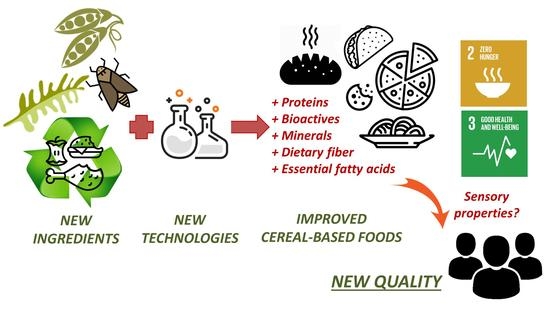Qualitative and Nutritional Improvement of Cereal-Based Foods and Beverages
Abstract
Author Contributions
Funding
Conflicts of Interest
References
- Kim, B.R.; Park, S.S.; Youn, G.J.; Kwak, Y.J.; Kim, M.J. Characteristics of Sunsik, a Cereal-Based Ready-to-Drink Korean Beverage, with Added Germinated Wheat and Herbal Plant Extract. Foods 2020, 9, 1654. [Google Scholar] [CrossRef] [PubMed]
- Ignat, M.V.; Salanță, L.C.; Pop, O.L.; Pop, C.R.; Tofană, M.; Mudura, E.; Coldea, T.E.; Borșa, A.; Pasqualone, A. Current functionality and potential improvements of non-alcoholic fermented cereal beverages. Foods 2020, 9, 1031. [Google Scholar] [CrossRef] [PubMed]
- United Nations. Resolution Adopted by the General Assembly on 25 September 2015. Transforming Our World: The 2030 Agenda for Sustainable Development. A/Res/70/1. 2015. Available online: https://www.un.org/ga/search/view_doc.asp?symbol=A/RES/70/1&Lang=E (accessed on 21 January 2021).
- Katzmarzyk, P.T.; Salbaum, J.M.; Heymsfield, S.B. Obesity, noncommunicable diseases, and COVID-19: A perfect storm. Am. J. Hum. Biol. 2020, e23484. [Google Scholar] [CrossRef]
- Pagani, M.A.; Giordano, D.; Cardone, G.; Pasqualone, A.; Casiraghi, M.C.; Erba, D.; Blandino, M.; Marti, A. Nutritional Features and Bread-Making Performance of Wholewheat: Does the Milling System Matter? Foods 2020, 9, 1035. [Google Scholar] [CrossRef] [PubMed]
- Parizad, P.A.; Marengo, M.; Bonomi, F.; Scarafoni, A.; Cecchini, C.; Pagani, M.A.; Marti, A.; Iametti, S. Bio-Functional and Structural Properties of Pasta Enriched with a Debranning Fraction from Purple Wheat. Foods 2020, 9, 163. [Google Scholar] [CrossRef] [PubMed]
- Fois, S.; Campus, M.; Piu, P.P.; Siliani, S.; Sanna, M.; Roggio, T.; Catzeddu, P. Fresh Pasta Manufactured with Fermented Whole Wheat Semolina: Physicochemical, Sensorial, and Nutritional Properties. Foods 2019, 8, 422. [Google Scholar] [CrossRef] [PubMed]
- Govender, L.; Siwela, M. The Effect of Moringa oleifera Leaf Powder on the Physical Quality, Nutritional Composition and Consumer Acceptability of White and Brown Breads. Foods 2020, 9, 910. [Google Scholar] [CrossRef] [PubMed]
- Rocchetti, G.; Rizzi, C.; Pasini, G.; Lucini, L.; Giuberti, G.; Simonato, B. Effect of Moringa oleifera L. Leaf Powder Addition on the Phenolic Bioaccessibility and on In Vitro Starch Digestibility of Durum Wheat Fresh Pasta. Foods 2020, 9, 628. [Google Scholar] [CrossRef] [PubMed]
- Pasqualone, A.; De Angelis, D.; Squeo, G.; Difonzo, G.; Caponio, F.; Summo, C. The Effect of the Addition of Apulian black Chickpea Flour on the Nutritional and Qualitative Properties of Durum Wheat-Based Bakery Products. Foods 2019, 8, 504. [Google Scholar] [CrossRef] [PubMed]
- Pasqualone, A.; Delcuratolo, D.; Gomes, T. Focaccia Italian flat fatty bread. In Flour and Breads and Their Fortification in Health and Disease Prevention, 1st ed.; Preedy, V.R., Watson, R.R., Patel, V.B., Eds.; Academic Press: Cambridge, MA, USA, 2011; pp. 47–58. [Google Scholar] [CrossRef]
- Schettino, R.; Pontonio, E.; Rizzello, C.G. Use of Fermented Hemp, Chickpea and Milling By-Products to Improve the Nutritional Value of Semolina Pasta. Foods 2019, 8, 604. [Google Scholar] [CrossRef] [PubMed]
- Chung, P.L.; Liaw, E.T.; Gavahian, M.; Chen, H.H. Development and Optimization of Djulis Sourdough Bread Using Taguchi Grey Relational Analysis. Foods 2020, 9, 1149. [Google Scholar] [CrossRef] [PubMed]
- Tobias-Espinoza, J.L.; Amaya-Guerra, C.A.; Quintero-Ramos, A.; Pérez-Carrillo, E.; Núñez-González, M.A.; Martínez-Bustos, F.; Meléndez-Pizarro, C.O.; Báez-González, J.G.; Ortega-Gutiérrez, J.A. Effects of the addition of flaxseed and amaranth on the physicochemical and functional properties of instant-extruded products. Foods 2019, 8, 183. [Google Scholar] [CrossRef] [PubMed]
- Subiria-Cueto, R.; Larqué-Saavedra, A.; Reyes-Vega, M.L.; de la Rosa, L.A.; Santana-Contreras, L.E.; Gaytán-Martínez, M.; Vázquez-Flores, A.A.; Rodrigo-García, J.; Corral-Avitia, A.Y.; Núñez-Gastélum, J.A.; et al. Brosimum alicastrum Sw. (Ramón): An Alternative to Improve the Nutritional Properties and Functional Potential of the Wheat Flour Tortilla. Foods 2019, 8, 613. [Google Scholar] [CrossRef] [PubMed]
- Awobusuyi, T.D.; Siwela, M.; Pillay, K. Sorghum–Insect Composites for Healthier Cookies: Nutritional, Functional, and Technological Evaluation. Foods 2020, 9, 1427. [Google Scholar] [CrossRef] [PubMed]
- Chanadang, S.; Chambers IV, E. Determination of the sensory characteristics of traditional and novel fortified blended foods used in supplementary feeding programs. Foods 2019, 8, 261. [Google Scholar] [CrossRef] [PubMed]
- Pasqualone, A.; Costantini, M.; Coldea, T.E.; Summo, C. Use of legumes in extrusion cooking: A review. Foods 2020, 9, 958. [Google Scholar] [CrossRef] [PubMed]
- Pasqualone, A.; Laddomada, B.; Boukid, F.; De Angelis, D.; Summo, C. Use of Almond Skins to Improve Nutritional and Functional Properties of Biscuits: An Example of Upcycling. Foods 2020, 9, 1705. [Google Scholar] [CrossRef] [PubMed]
- Beltrán-Medina, E.A.; Guatemala-Morales, G.M.; Padilla-Camberos, E.; Corona-González, R.I.; Mondragón-Cortez, P.M.; Arriola-Guevara, E. Evaluation of the Use of a Coffee Industry By-Product in a Cereal-Based Extruded Food Product. Foods 2020, 9, 1008. [Google Scholar] [CrossRef] [PubMed]
- Ozuna, C.; Trueba-Vázquez, E.; Moraga, G.; Llorca, E.; Hernando, I. Agave Syrup as an Alternative to Sucrose in Muffins: Impacts on Rheological, Microstructural, Physical, and Sensorial Properties. Foods 2020, 9, 895. [Google Scholar] [CrossRef] [PubMed]
- Arena, E.; Muccilli, S.; Mazzaglia, A.; Giannone, V.; Brighina, S.; Rapisarda, P.; Fallico, B.; Allegra, M.; Spina, A. Development of Durum Wheat Breads Low in Sodium Using a Natural Low-Sodium Sea Salt. Foods 2020, 9, 752. [Google Scholar] [CrossRef] [PubMed]
Publisher’s Note: MDPI stays neutral with regard to jurisdictional claims in published maps and institutional affiliations. |
© 2021 by the authors. Licensee MDPI, Basel, Switzerland. This article is an open access article distributed under the terms and conditions of the Creative Commons Attribution (CC BY) license (http://creativecommons.org/licenses/by/4.0/).
Share and Cite
Pasqualone, A.; Summo, C. Qualitative and Nutritional Improvement of Cereal-Based Foods and Beverages. Foods 2021, 10, 338. https://doi.org/10.3390/foods10020338
Pasqualone A, Summo C. Qualitative and Nutritional Improvement of Cereal-Based Foods and Beverages. Foods. 2021; 10(2):338. https://doi.org/10.3390/foods10020338
Chicago/Turabian StylePasqualone, Antonella, and Carmine Summo. 2021. "Qualitative and Nutritional Improvement of Cereal-Based Foods and Beverages" Foods 10, no. 2: 338. https://doi.org/10.3390/foods10020338
APA StylePasqualone, A., & Summo, C. (2021). Qualitative and Nutritional Improvement of Cereal-Based Foods and Beverages. Foods, 10(2), 338. https://doi.org/10.3390/foods10020338






